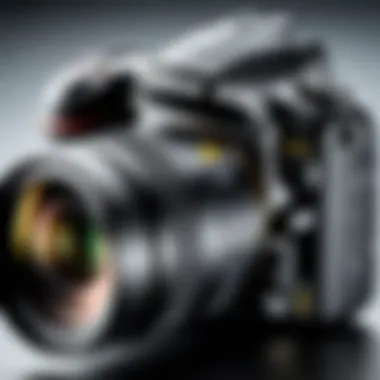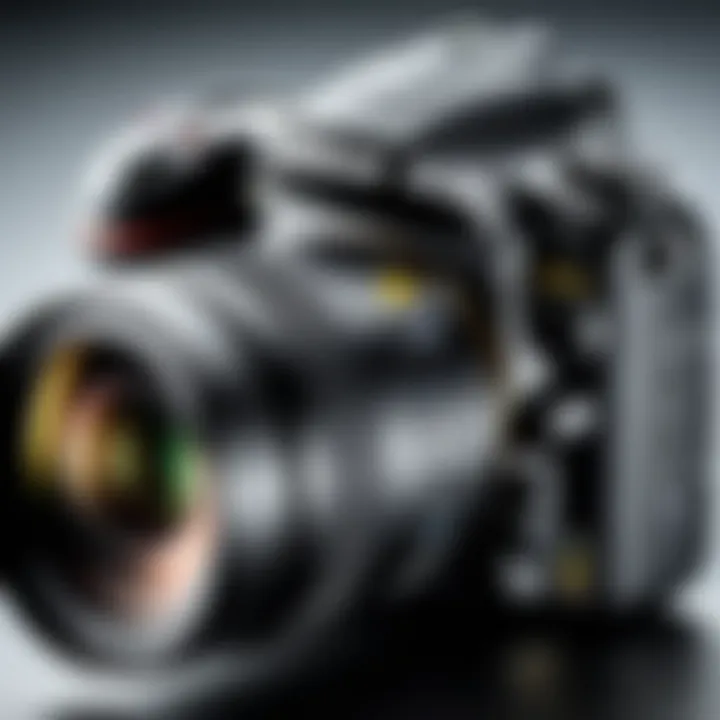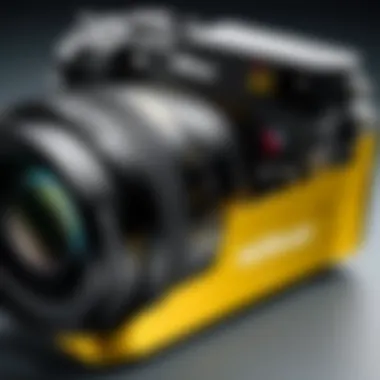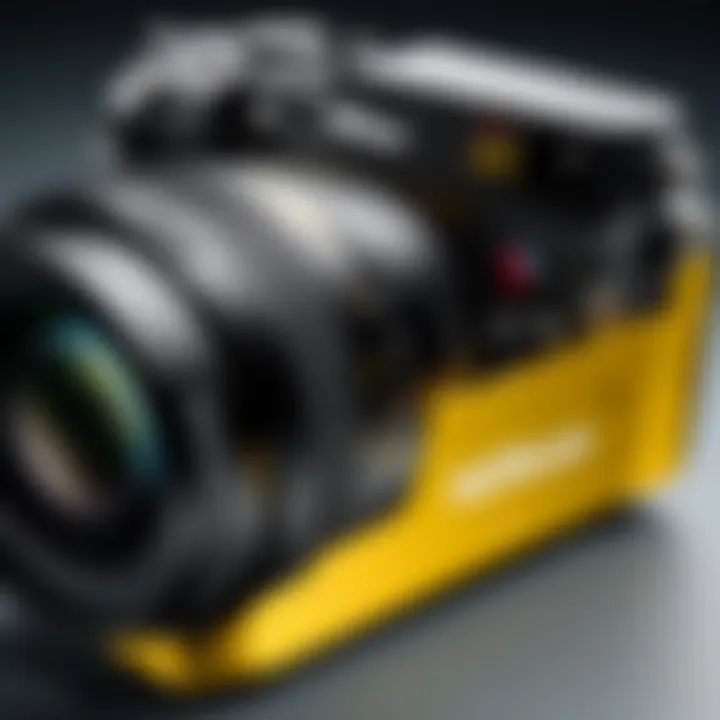Explore Nikon Cameras with WiFi and Bluetooth Features


Intro
In the rapidly evolving landscape of photography, connectivity has become a pivotal factor for both amateur and professional photographers. Nikon cameras equipped with WiFi and Bluetooth technology have emerged as leading tools that redefine the way users capture and manage images. This section dives into the core aspects of these advanced functionalities, exploring how they enhance the user experience.
Wireless connectivity not only simplifies the process of transferring images but also allows for remote control of the camera. This opens new avenues for creativity, making it easier to shoot from challenging angles or settings. Understanding the technical specifications and usability features of Nikon's WiFi and Bluetooth-enabled cameras provides a clearer picture of their advantages in diverse photographic contexts.
As we examine these models, we will touch upon their technical specifications, compare them to competitors, and highlight practical applications and trends in the photography industry. This exploration aims to assist users in grasping the full value and capabilities of Nikon's innovative products. Explore further, as we dissect each section of the analysis to ensure that your photographic journey is both informed and effective.
Technical Specifications
Detailed Product Specs
Nikon's range of WiFi and Bluetooth-equipped cameras includes models such as the Nikon Z50 and the Nikon D7500. These models feature impressive sensor capabilities, often boasting APS-C or full-frame sensors, high ISO performance, and fast autofocus systems. The specifications can differ significantly across models, so it is imperative for users to examine individual features closely based on their specific photography needs.
Performance Metrics
Across the spectrum, Nikon cameras generally deliver excellent image quality with high resolution and vibrant colors. The autofocus systems are recognized for their speed and accuracy, crucial for capturing fast-moving subjects. Typically, users can expect burst shooting rates of up to 10 frames per second or higher, depending on the model. Battery life often exceeds 800 shots per charge, allowing for extensive shooting sessions.
Compatibility Information
Nikon's cameras with WiFi and Bluetooth functionality are compatible with various devices, including smartphones and tablets. Using the Nikon SnapBridge app, users can seamlessly connect their cameras to mobile devices for easy sharing and remote control. This compatibility extends to widely-used operating systems like iOS and Android, enhancing the overall utility of these cameras in everyday situations.
Product Comparisons
Feature Comparisons
When analyzing Nikon cameras, it is essential to compare them with competitor products like Canon and Sony. For instance, while Nikon offers exceptional low-light performance and robust build quality, Canon models may excel in color science and user interface. Each brand brings unique strengths, making it necessary for users to evaluate features that matter most to their photographic style.
Price Breakdown
The pricing of Nikon's WiFi and Bluetooth cameras varies widely, reflecting specifications and build quality. Models such as the Nikon Z50 might cater to entry-level enthusiasts, while higher-end options like the Nikon D850 appeal to seasoned professionals. Users should benchmark the features against their budget to find the most suitable option without compromising on critical specifications.
User Experience Breakdown
User experiences often vary with Nikon cameras based on individual preferences and usage styles. Overall, Nikon cameras are praised for their ergonomics and intuitive controls. However, some users may experience a learning curve due to the complex menu systems. Reviews highlight the importance of hands-on testing to determine which camera aligns with individual expectations.
Practical Applications
Use Cases for Different Users
Nikon's WiFi and Bluetooth capabilities cater to diverse photographer types. Casual users benefit from quick sharing options for social media, while professionals can leverage remote shooting for complex setups. Landscapes, portraits, and action sports each have tailored uses for these functionalities, significantly enhancing the photography process.
Recommended Configurations
For optimal performance, users are encouraged to select camera settings that match their subject and environment. Utilizing WiFi for real-time previews can aid in composition, while Bluetooth can be used for seamless uploads to cloud services. Understanding these configurations is essential to maximize the technology's capabilities.
Multi-Platform Performances
The ability to integrate Nikon cameras with various platforms exponentially increases their utility. Whether uploading images directly to platforms such as Facebook or using editing software on a laptop, the connections facilitate a streamlined workflow. This adaptability is vital in today’s fast-paced digital landscape.
Latest Trends
Industry Developments
The camera industry is witnessing significant shifts towards smart technology integration. Nikon has been responsive to these trends, incorporating upgraded software and hardware features to stay competitive. Users are encouraged to stay informed on these developments to make educated purchases.
Emerging Technologies
As technology advances, features like improved image stabilization, faster data transfer speeds, and AI-driven functionalities are being integrated into Nikon's offerings. These innovations promise to enhance the user experience even further, pushing the boundaries of what is achievable in photography.
Future Predictions
Looking ahead, it is plausible that Nikon will continue to expand its range of connected devices, perhaps focusing on integration with smart home technologies. Predicting the market's demand for connectivity will play a vital role in shaping Nikon's future innovations.
Buying Guides
Recommended Products
While individual preferences will vary, popular choices among users include the Nikon Z6 for its low-light performance or the Nikon D5600 for an affordable yet capable entry-level option. Evaluating user reviews and detailed specifications can guide your decision.


Purchasing Tips
When considering a Nikon camera, ensure to check for promotions or bundled accessories that may come with the purchase. These can often provide added value and enhance overall usage experiences.
Warranty and Support Information
Nikon generally offers reliable warranty coverage on their cameras, which varies by model. It is advisable to familiarize oneself with the warranty terms, and seeking customer support can provide additional reassurance for new users.
A well-informed decision often stem from thorough research and an understanding of personal needs.
Intro to Nikon Cameras
Nikon has established itself as a leading name in the photography industry, offering a diverse range of cameras that cater to various skill levels and photographic needs. Understanding Nikon's offerings is crucial for anyone interested in acquiring a camera that incorporates modern technology, such as WiFi and Bluetooth. These advanced features significantly enhance the usability and functionality of their cameras, making them attractive to both casual users and seasoned professionals.
Overview of Nikon's Camera Lineup
Nikon’s lineup includes a variety of DSLR and mirrorless cameras. Each series is designed to meet specific requirements. For instance, the D series appeals to traditionalists who appreciate the optical viewfinder and the stability of a DSLR. On the other hand, the Z series, which includes mirrorless options, emphasizes portability and electronic features.
Key models in each category are as follows:
- D7500: Targeted at enthusiast photographers, it offers a strong blend of features with solid performance.
- Z6 II: A full-frame mirrorless camera that supports high-resolution images while incorporating advanced features like 4K video recording.
- D850: A high-resolution DSLR that is favored by professionals for its superior image quality.
These options illustrate how Nikon appeals to a wide audience, from hobbyists to professionals seeking specific functionalities in their photographic equipment.
Understanding WiFi and Bluetooth Technology
WiFi and Bluetooth are integral to modern photography, allowing seamless connectivity between the camera and other smart devices. Understanding their function is imperative.
WiFi Technology
WiFi functionality enables cameras to connect directly to the internet or a local network. It allows users to:
- Upload images directly to cloud services or social media platforms.
- Control the camera remotely via a smartphone or tablet. This is particularly useful for group shots or wildlife photography, where interacting with the camera might scare off the subjects.
Bluetooth Technology
Bluetooth support offers a simpler way to maintain a connection with smartphones or tablets. It generally consumes less power compared to WiFi, thus prolonging the camera's battery life. Key benefits include:
- Automatic pairing with devices for quick access to photos.
- A stable connection that allows for constant backup of images.
Incorporating these technologies into Nikon’s cameras allows for enhanced usability and convenience, making photography more accessible in an increasingly digital landscape.
Key Features of Nikon Cameras with Connectivity
Nikon cameras equipped with WiFi and Bluetooth technology offer a range of features that significantly enhance their usability. These connectivity options facilitate a seamless experience, whether for casual users or professionals. Understanding the key features is essential for anyone considering a Nikon camera for their photography needs.
WiFi Capabilities
Remote Shooting Options
The remote shooting functionality of Nikon cameras is a remarkable feature. This allows users to operate their camera from a distance using a smart device. This capability is especially useful for studio photography or nature shots, where getting physically close would disturb the subject. By using the Nikon SnapBridge app, users can connect their camera directly to their smartphone or tablet.
Key characteristics of remote shooting include its ease of use and flexibility. For instance, photographers can set the camera on a tripod and adjust settings or take shots without manually pressing the shutter button. However, while convenient, it requires a strong WiFi connection to work effectively. If the signal is weak, it might lead to latency issues, which can result in missed opportunities during crucial moments.
Instant Image Sharing
Instant image sharing is another vital aspect of Nikon’s WiFi capabilities. After capturing photos, users can instantly upload them to social media or share them with friends via their connected devices. This feature meets the modern need for rapid content dissemination, especially for influencers and professionals.
The key advantage here is the immediacy of sharing photos. Nikon cameras facilitate quick uploads, allowing photographers to showcase their work almost in real time. This can be particularly beneficial at events like weddings or concerts. However, it is important to note that high-resolution images might take longer to upload, depending on the internet connection speed.
Bluetooth Functionality
Low Power Consumption
Nikon cameras with Bluetooth functionality utilize low power consumption technology. This helps maintain a connection with smart devices without draining the camera’s battery excessively. By using Bluetooth, photographers can establish a continuous link to their smartphones, enabling easy transfers of images.
The notable feature of low power consumption is its effectiveness in prolonging battery life, which is a crucial consideration for any photographer. It is a beneficial aspect, especially for those who engage in extended shooting sessions. While Bluetooth functionality is reliable, users must ensure that their smart devices are also charged to avoid disruptions.
Continuous Connection with Smart Devices


Continuous connection with smart devices is highly advantageous for Nikon camera users. It allows photographers to maintain an ongoing link with their mobile devices, which can be utilized for various functions, including firmware updates and image sharing.
This feature greatly enhances the overall user experience. Photographers don’t have to constantly reconnect their devices, simplifying the process of managing content and camera settings. However, a potential downside is that while Bluetooth connections generally do not interrupt other Bluetooth services, they may occasionally face interference in crowded areas, resulting in disconnection.
Advantages of Wireless Connectivity
Wireless connectivity in Nikon cameras equipped with WiFi and Bluetooth provides various benefits that enhance the overall user experience. In today's fast-paced digital landscape, these features play a significant role in how photographers capture, edit, and share their work. Understanding these advantages helps users make informed choices based on their specific needs and preferences.
Convenient Photo Sharing
One of the primary benefits of having WiFi and Bluetooth on Nikon cameras is the ability to share photos instantly. Traditional methods of transferring images can be time-consuming and cumbersome. With WiFi capabilities, photographers can upload photos directly to social media platforms or cloud storage. This immediacy allows for real-time sharing, which is particularly useful during events like weddings or public gatherings.
- Direct Uploads: Images can be sent directly from the camera to platforms like Facebook or Instagram without the need for a computer.
- Use of Mobile Apps: Nikon's SnapBridge app provides a seamless way to link the camera with smartphones, simplifying the upload process.
This functionality empowers users to broadcast their creativity quickly, making moments accessible and sharable with minimal effort.
Enhanced Workflow for Professionals
For professional photographers, time management and efficiency are critical. The incorporation of WiFi and Bluetooth into Nikon cameras facilitates a more streamlined workflow. This can be broken down into various aspects:
- Remote Control: Photographers can adjust settings remotely from their smartphone or tablet. This is essential for capturing shots at difficult angles or during long exposure photography.
- Instant Backup: Connecting to cloud storage through WiFi allows users to create backups of images as they are taken, reducing the risk of loss.
- Collaboration: By enabling easy sharing, professionals can collaborate more efficiently with clients and other creatives, sharing proofs and getting immediate feedback.
The integration of connectivity features in modern cameras is not just a trend; it represents a fundamental shift in how photography is approached and executed in various fields.
Technical Specifications Comparison
Technical specifications comparison is crucial in understanding the capabilities and performance of Nikon cameras equipped with WiFi and Bluetooth technology. It allows photographers to make informed decisions based on their specific needs and requirements. With the range of models available, knowing the specs helps to highlight the features that matter most, such as image quality, connectivity speed, and usability in different scenarios.
A comprehensive comparison between various models helps to identify strengths and weaknesses, ensuring that users pick a camera that aligns with their creative objectives.
Nikon Models with WiFi and Bluetooth
Nikon offers a diverse range of cameras that include WiFi and Bluetooth capabilities, catering to both amateur and professional photographers. Key models that integrate these technologies include the Nikon Z50, D7500, and Z6 II. Each of these models brings unique features to the table:
- Nikon Z50: This mirrorless camera stands out for its compact design while still providing excellent connectivity options. It utilizes the SnapBridge app, enabling remote shooting and instant sharing of images.
- Nikon D7500: A versatile DSLR that combines advanced features with a robust build. It offers seamless connectivity via WiFi and Bluetooth, facilitating a smooth workflow especially in dynamic settings.
- Nikon Z6 II: This full-frame mirrorless camera caters to professionals requiring high-quality performance. Its dual card slots and advanced image processing enhance workflow efficiency.
These models not only excel in photography but also provide a solid framework for versatile connectivity, making them suitable for various photography needs.
Comparison with Competitor Models
When evaluating Nikon cameras with WiFi and Bluetooth, it is essential to compare them with competitor models to get a well-rounded view. Brands like Canon and Sony also offer cameras with similar features.
- Canon EOS M50 Mark II: This compact mirrorless camera competes well with Nikon’s options. It has an easy-to-use interface and allows for live streaming, but some users find its connectivity features less robust compared to Nikon’s offering.
- Sony A6400: Known for its superior autofocus, the A6400 provides excellent connectivity options. However, its battery life can be a concern for long shoots, making Nikon’s D7500 a more suitable choice for prolonged use.
- Fujifilm X-T4: While it offers impressive image quality and stabilization, its connectivity features are not as user-friendly as those found in Nikon cameras. Photographers seeking a balance between performance and convenience may find Nikon’s models more appealing.
Usage Scenarios
Understanding the practical applications of Nikon cameras equipped with WiFi and Bluetooth is vital for photographers looking to enhance their skills. These connectivity features significantly elevate how photographers can capture, store, and share images. The importance of identifying usage scenarios cannot be understated. It provides insights into how these technological advancements can directly influence shooting practices, efficiency in workflow, and the overall photographic experience.
For Travel Photographers
Travel photographers often find themselves in dynamic environments where flexibility is essential. Nikon cameras with WiFi and Bluetooth enable them to transfer images instantly to their mobile devices. This allows for quick editing and sharing on social media platforms. Additionally, the ability to remote shoot using the camera's app means that photographers can capture hard-to-reach shots, such as group images or landscapes without being present behind the lens. This feature maximizes their creative potential and allows them to focus on storytelling while maintaining a streamlined workflow.
Event and Wedding Photography
Event and wedding photography requires not only artistic vision but also punctuality. Nikon's connectivity options facilitate picture uploads to cloud services as they are taken. This feature acts as a backup while still sharing images in real-time with event organizers or guests who desire moments captured without delay. Moreover, using Bluetooth to connect with devices ensures that photographers can maintain a constant line of communication with their team, streamlining the coordination of group shots or special moments. This seamless connection enhances professionalism and client satisfaction, ensuring contentment with the final product.
Action and Sports Photography
Photographing fast-paced events like sports requires not only skill but also quick access to tools. Nikon cameras equipped with WiFi and Bluetooth give sports photographers the chance to share images with newsrooms or social media in real-time. This immediate transfer is invaluable for keeping fans updated and engaged. Furthermore, remote shooting is especially helpful in capturing crucial moments from a distance, such as during high-energy games or competitions. The continuous connectivity not only improves workflow but also helps in ensuring that no important moment goes uncaptured.
The integration of WiFi and Bluetooth in Nikon cameras reflects the brand's commitment to adapting to the evolving landscape of photography.
Challenges of Using Wireless Features
The integration of WiFi and Bluetooth in Nikon cameras elevates the photography experience significantly. However, these wireless features come with their own set of challenges that photographers need to address. Understanding these challenges is crucial because they can directly impact the usability and effectiveness of the camera in various scenarios, from casual outings to professional shoots.
Connection Stability Issues
One of the most common challenges encountered by users is connection stability. Various factors can impact the reliability of WiFi and Bluetooth connections, including environmental conditions and device compatibility. In crowded locations, such as events or urban areas, interference from other wireless signals can hinder connection quality. This can lead to delays during remote shooting or interruptions in photo transfers, which are detrimental during critical moments.


Moreover, the stability of the connection can vary depending on the distance between the camera and the connected device whether it's a smartphone or a tablet. In general, the further apart the devices are, the weaker the connection becomes. Photographers often find themselves grappling with disruptions that can cause frustration.
To mitigate these issues, users can take some practical steps:
- Limit distance: Maintain a reasonable distance between the camera and the smart device to keep the connection strong.
- Change location: If you encounter issues, moving to a less crowded area may enhance the WiFi quality.
- Update firmware: Regularly updating the camera's firmware can improve connectivity and resolve known issues.
Maintaining a stable connection is essential for effective use of WiFi and Bluetooth features in Nikon cameras.
Battery Life Considerations
Another significant challenge with using WiFi and Bluetooth features is battery consumption. Wireless connectivity can drain battery power faster than traditional usage. This is particularly concerning for photographers who rely on their equipment for extended periods, as an unexpected battery depletion can inhibit their ability to capture important moments.
Nikon cameras equipped with WiFi and Bluetooth tend to use more power while these features are active. This means that photographers must manage their battery life more carefully. Here are some strategies to optimize battery usage:
- Turn off wireless features when not in use: Disabling WiFi and Bluetooth when not actively sharing or shooting can preserve battery life.
- Use power-saving mode: Many Nikon models come with power-saving options that can help extend battery life during shooting.
- Carry spare batteries: Having extra charged batteries on hand ensures that you are never caught without power during critical shooting situations.
User Experience and Reviews
User experience and reviews play a critical role in understanding the real-world performance of Nikon cameras with WiFi and Bluetooth connectivity. These feedback mechanisms help potential buyers evaluate how well these features function in everyday settings. Moreover, insights gained from user experiences can guide product improvements and inform future versions of Nikon cameras.
Professional Photographer Feedback
Professional photographers often have high expectations for their tools. When it comes to Nikon cameras equipped with wireless technology, they appreciate specific aspects such as:
- Image Quality: Many professionals emphasize the importance of image quality in their reviews. They often find that Nikon camera systems deliver exceptional performance even under challenging conditions. The seamless integration of WiFi and Bluetooth does not compromise this quality.
- Ease of Use: For professionals, time is money. Therefore, features that allow for quick sharing of images are crucial. Users particularly highlight how WiFi connectivity allows for instant transfers, making it easier to send images to clients or social media without additional hardware.
- Remote Shooting: The remote shooting options provided by these cameras receive positive feedback. Photographers appreciate how these features allow them to manage shots from a distance, minimizing disruptions to a scene they are capturing.
In summary, professional photographers generally find Nikon's WiFi and Bluetooth functionalities to be reliable and advantageous.
Casual User Experiences
Casual users often approach Nikon's connected models with different priorities compared to professionals. Many casual photographers value:
- Accessibility: Users appreciate how easy it is to connect their Nikon cameras to smartphones or tablets. Whether through the SnapBridge app or other software, casual users find these processes intuitive.
- Versatile Sharing: Sharing photos online is essential for casual users. They often rave about the capabilities provided by WiFi and Bluetooth to easily upload to platforms like Facebook or Instagram.
- General Performance: While not as demanding as professionals, casual users look for a camera that performs well across various situations. Their reviews often reflect satisfaction with Nikon’s offerings, citing ease of use and function.
Overall, casual users praise the convenience that WiFi and Bluetooth add to their photography experience. They find value in features that enhance sharing and accessibility without compromising image quality.
“If you want a camera that can keep up with your lifestyle and social media habits, Nikon's connected models are highly effective.”
Future Trends in Camera Connectivity
As technology rapidly evolves, so does the landscape of camera connectivity. Understanding these trends is essential for both casual users and professionals who seek to enhance their photographic experience. With growing demand for instant sharing and seamless integration with smart devices, manufacturers are focusing on delivering advanced connectivity options. This section delves into these emerging technologies and potential upgrades, emphasizing their significance in the Nikon camera ecosystem.
Emerging Technologies
Camera connectivity is on the verge of significant innovation. Here are some noteworthy trends that are shaping the future:
- 5G Integration: With the rollout of 5G networks, cameras may soon utilize this technology for faster and more stable connectivity. Photographers will benefit from quicker uploads, live streaming capabilities, and real-time collaboration with others.
- Improved AI Functionality: Artificial intelligence is being integrated into camera systems, enhancing user experience. For instance, automatic optimization of image settings based on the environment will make photography more accessible to beginners while providing professionals with more control over their shots.
- Advanced Cloud Services: More companies are exploring cloud solutions to facilitate easier storage and sharing. This means photographers could back up their images instantly or collaborate with others directly from their cameras.
In essence, these technologies promise to elevate the connectivity experience, making photography more intuitive and efficient.
Potential Upgrades for Existing Models
Old Nikon camera models could see significant enhancements if manufacturers implement forward-looking features. Some potential upgrades include:
- Software Updates: Current cameras may receive software revisions that integrate emerging features without the need for new hardware. This keeps older models relevant and capable of utilizing new technologies.
- Enhanced Battery Management: As connectivity features, such as WiFi and Bluetooth, consume power, improving battery life or introducing power-saving modes is vital. Upgrades may lead to longer operational times without sacrificing performance.
- User Interface Improvements: A more intuitive interface can facilitate the use of wireless features. Simplifying connectivity processes and incorporating touchscreens or voice controls would make it easier for all users.
Each of these upgrades has the potential to significantly improve user experiences while assuring that Nikon cameras remain competitive in an ever-evolving market.
"The future of camera connectivity isn't just about what's available; it's about how these options can transform the way we capture and share our worlds."
End
Summarizing the Importance of Connectivity
The role of wireless connectivity in modern photography cannot be understated. With Nikon cameras equipped with WiFi and Bluetooth, users can experience a significant shift in how they capture and share images. These technologies offer a seamless way to transfer photos directly to smart devices. This means that photographers no longer need to rely on cables or card readers. Moreover, being able to share images instantly enhances user engagement and outreach.
Wireless connectivity also brings an array of practical benefits. Features like remote shooting enable photographers to capture images without being physically present behind the camera. This is particularly useful for wildlife or landscape photography, where the photographer should maintain a distance. The integration of connectivity in Nikon's design also simplifies the workflow. Professionals can immediately send images for editing or social media posting, streamlining their processes.
As the photographic landscape evolves, understanding these connections becomes vital. The convenience they provide can lead to increased creativity and experimentation among users.
Final Thoughts on Nikon's Approach
Nikon has positioned itself strategically by incorporating WiFi and Bluetooth technologies into its cameras. The company recognizes that today's photographers demand flexibility and ease of use. By equipping their cameras with these features, Nikon ensures that users can quickly adapt to their creative needs.
Additionally, the commitment to advanced connectivity reflects Nikon's responsiveness to market trends. As competitors also enhance their offerings, continuing to innovate will be crucial. Future upgrades are likely to focus on improving connection stability and battery efficiency, addressing some of the current limitations users face.







